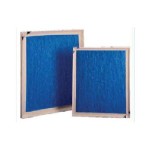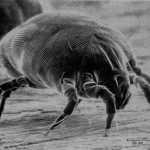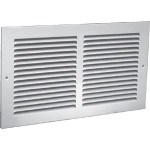
Disposable fiberglass filters
What is the first thing you think of when you hear the word “filter”? Depending on whether you’re a coffee drinker, a smoker or an auto mechanic (and in many cases, all of the above), the word may bring up very different images, but no matter which kind of filter you’re thinking of, a filter’s purpose is universal: to allow the unnecessary elements to come through while blocking the unnecessary ones. In a heating and air conditioning system, the necessary element is air and the unnecessary, and often harmful elements are dust, pollen, mold, bacteria, smoke and chemicals traveling through the air. We’ll explore how this simple square of material has so much influence and the easy steps you can take to make the influence a positive one.
Can You Feel It Coming in the Air Tonight?
It’s the one thing that you’ll have to do until the day you die—No, not pay taxes, breathe. At least 12 times a minute, you draw air into your lungs to absorb oxygen and release carbon dioxide. Of course, when you breathe, you’re not only taking in oxygen, but whatever else happens to be floating in the air around you. Unfortunately, when you’re indoors, the air you’re breathing can be 2-5 times more contaminated than the air outside.

A charming, little dust mite
Here’s a short list of some nasty elements that hitch a ride on the air in your home:
- Pollen
- Mold
- Dust
- Pet hair and dander
- Bacteria
- Dust mites
- Formaldehyde
Some of these I’m sure you expected to see, and others, like formaldehyde may come as a surprise. Formaldehyde is used in carpets, furniture, cleaning products and building materials and is something you would rather not have inside your body.
But don’t panic.
The average human immune system is amazingly good at dealing with toxins and you don’t need to walk around your home wearing a surgical mask. You might, however, make its job a little easier by filtering the air that circulates in your home before it even enters your body.
Keep It Clean!
As important as your body is, you should also take into consideration the health of your air conditioning unit. Properly installed and maintained, your central air conditioning system should work beautifully for around 12-15 years. Poorly maintained? You run the risk of developing some inconvenient and costly mechanical issues. They will also likely choose to happen during the hottest days of summer while you have family visiting from out of town (no, this isn’t necessarily true, but some people have extraordinarily bad luck).
In a desert climate with notoriously windy Spring months, it’s especially important to block as much dirt as you can from entering the air conditioning system. Dirt can accumulate in the ducts, on fan blades and the coil. This build-up can block air flow and slow down performance.
The filter is going to keep out much of the dirt, but after a while it will catch so much that the air will also have trouble getting through. That’s when a filter change is long overdue.
Okay, So What Am I Looking For Exactly?

Dynamic Air Cleaner
Air filters are usually fairly thin, framed squares of fine synthetic fibers that are coated in resins that block the pollutants. There are several types of filters in varying degrees of thickness, density and durability. Some of the more effective types have electrical/electrostatic enhancements that actively grab the moving particles.
Here’s a quick run-down of the different types:
- Disposable fiberglass – Your least expensive option and the most common. It’s about 1-2” thick and meant to be changed after 30 days. They usually come in cases of a dozen.
- Washable – Instead of disposing of the filter every month, a washable filter just needs to be rinsed every month and you can get away with using the same one for over a year.
- Pleated – These are made of denser material than fiberglass, so they catch smaller particles and will last you 2-3 months.
- Deep pleated – Depending on your system, it may not fit, but deep pleated filters are several inches thicker than standard filters and have a lifespan of around a year.
- Electrostatic – The added quality of being electrostatic makes these kinds of filters a bit more efficient, so you can expect higher prices. Both disposable and reusable electrostatic filters are available.
- Electronic air cleaner – The crown jewel of home air filtration is the electronic air cleaner. Expect to invest a few hundred dollars and understand that you’ll still have to buy replacement media (which cost about as much as pleated filters), but for people who suffer from allergies, asthma or other respiratory problems, the electronic air cleaner is the best option for your health.
MERV!? MERV Who?
You’ll often come across this word when shopping for filters. MERV stands for Minimum Efficiency Reporting Value and measures efficiency of capturing particles of smaller and smaller size. There are 20 levels in all, 1 being the lowest and 20 being the highest.
Here’s a list of the MERV values and, to put them into perspective, the types of pollutants targeted, typical application and the products listed above.
|
MERV |
Description |
|
17-20 |
Unless you’ve turned your home into a microbiology or pharmaceutical lab, filtration at this level isn’t really practical. Within this range, viruses carbon dust and carcinogens are what’s being screened out. |
|
15 -16 |
You’re in hospital sanitation range here and looking to keep out bacteria. Again, heavy duty filters like these are not necessary for the average home. |
|
13 -14 |
The particles of tobacco smoke can be tackled by filters with this rating and most of those filters are meant for commercial applications. |
|
9 -12 |
Products with these values filter out fine dusts, fumes and auto emissions. This is still widely considered a commercial filter range, but residential electronic air cleaners are available with these efficiency values. |
|
5 – 8 |
Various dusts, sprays and mold spores can be filtered out at these levels, which are common for filters in many standard commercial and high-end residential buildings. Pleated and electrostatic filters are often advertised with these numbers. |
|
1 – 4 |
You’re now at minimum residential filtration. Filters will still be able to catch particles like fibers, some types of dust, pollens and mites. Your disposable and washable filters most likely have values within this range. |
So, what’s the right level for you? The average homeowner will probably not need to consider anything above MERV 13, and filters with some of the lower-middle values should be fine for most, provided they’re changed/washed regularly. People with respiratory issues or homes prone to some of the pollutants talked about above might feel more comfortable with filtration in the MERV 8-12 range.
This One’s Dirty. Get Me a Clean One!
Depending on what kind of filter you have, after a month or more of collecting pollutants, your filter will be full and will need to be washed or changed. Not a problem, though. Changing your filter out is easy.
Here are the steps:
- Locate the return air grille. It’ll likely be a large vent at knee level. If you put your hand in front of it and feel it sucking air, you found it.
- Turn off the unit. Just to make the process safe and less annoying.
- Open the grille and remove the old filter. You’ll probably need a screwdriver for this, but that’s all. Pay attention to how the filter was inserted while you’re pulling it out.
- Slide the new filter in and close the grille. Pop the grille back on and you’re done.

Return air grille
That’s it, but here are some obvious, but important things to keep in mind while you’re changing out your filter:
- Make sure you get the right size. You should find the dimensions printed on the side of the frame of your existing filter.
- Insert the filter correctly. Look for the arrows.
- Note the date the filter was changed. You can take a marker and write the date on the frame and mark a future date for when you plan to check the filter again.
So, Am I Supposed to Get These Filters from You?
It’s always wise to shop around, but we won’t have any problems finding filters for you if you want to buy them from us. We also proudly offer Dynamic Air Cleaners, which have become increasing popular with our customer base.
Submit your request through our contact form or give us a call at (575) 523-4381 to see if we have what you need in stock. If we don’t, we’ll order it for you and have it ready as soon as possible.

